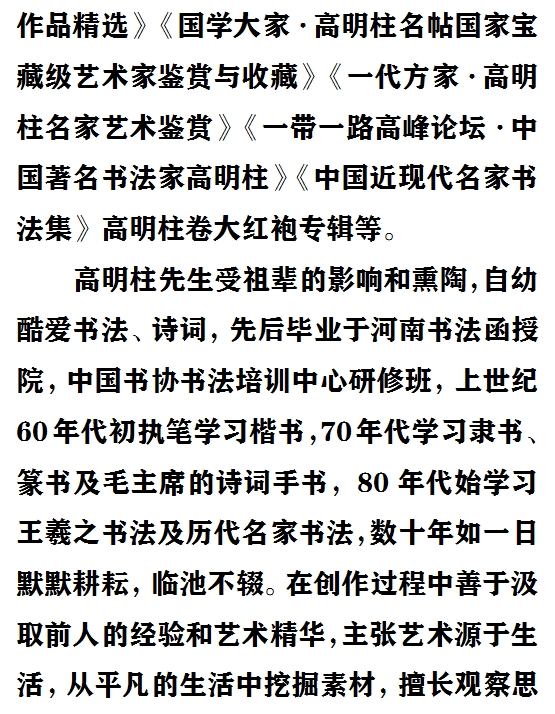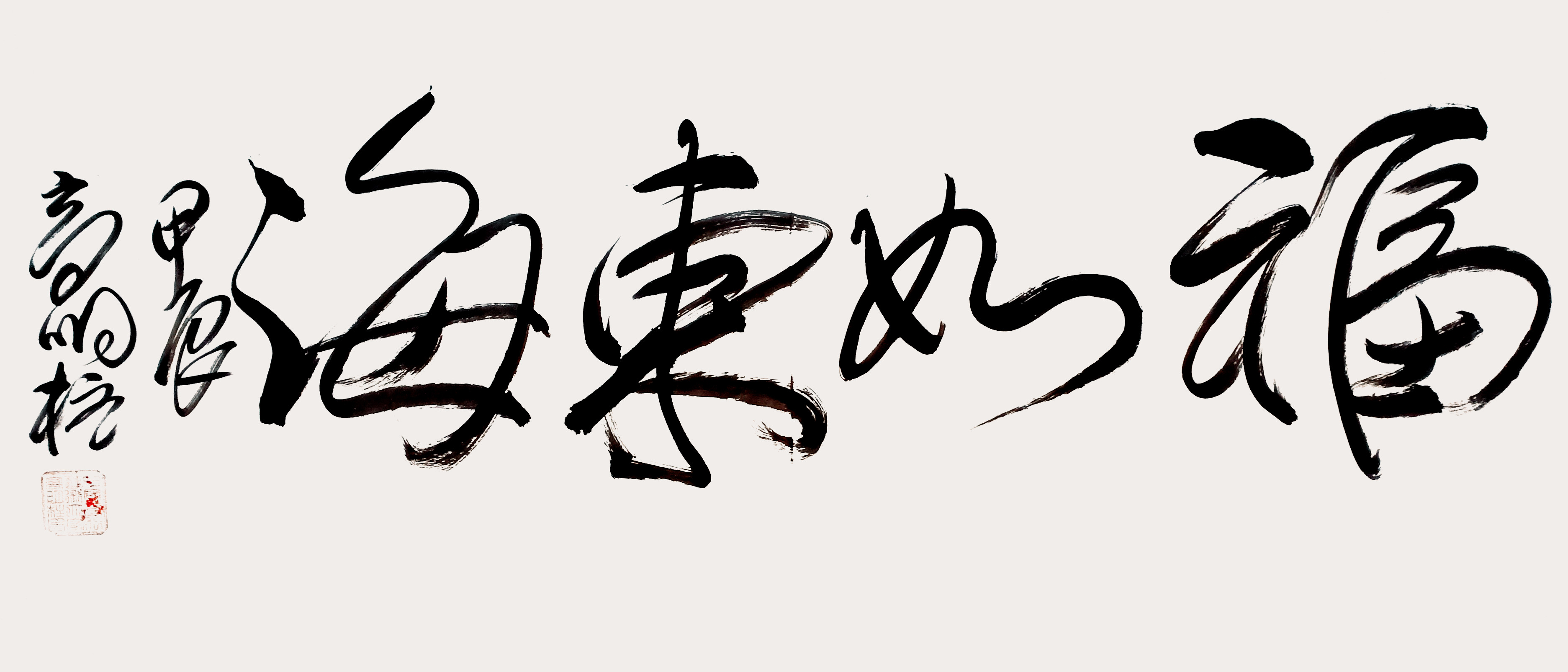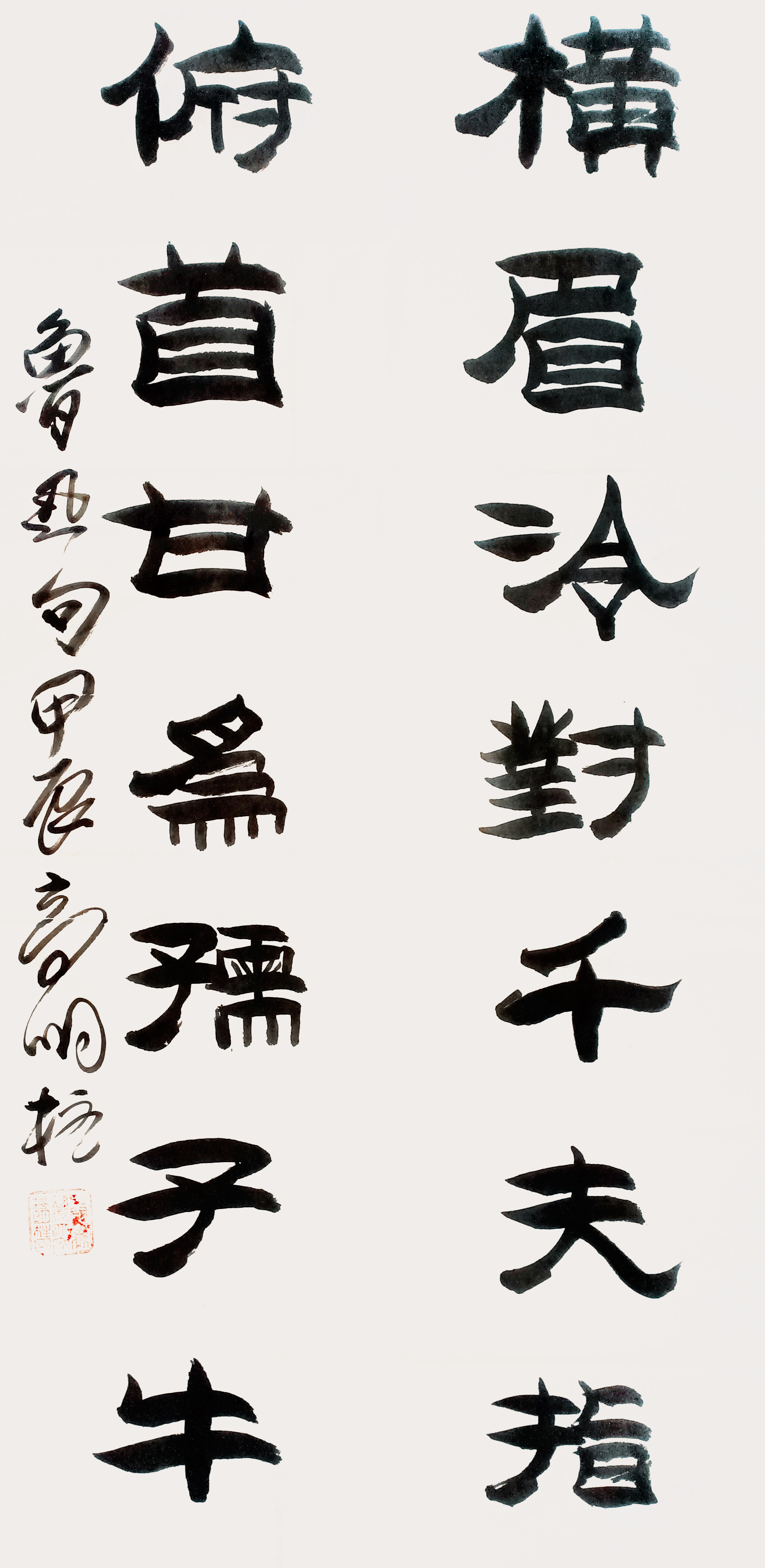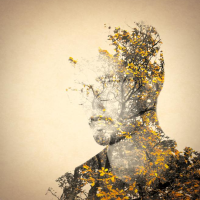






















Gao Mingzhu, born in August 1952, with the courtesy name Jingzhi and the pen name Xunjingzhai, was originally from Dengzhou, Henan. He resides in Beijing and is a calligrapher, poet, master of traditional Chinese culture, and a century old master. He was awarded the "Five One Projects" prize. He is currently the Honorary Vice President of Xiling Seal Engravers Society, the Minister of Traditional Chinese Art Inheritance of the State Administration of Press and Publication, and has been appointed as the Art Advisor of the New Era Culture and Art Talent Center by the China Federation of Literary and Art Circles and the Culture and Art Talent Center of the Ministry of Culture. He is also the Art Advisor of the Social Art Professional Committee of the China Oriental Culture Research Association. Member of the Chinese Popular Literature and Art Research Association, member of the Chinese Poetry Society, Chinese Calligraphers Association, and Central State Calligraphers Association, member of the People's Fine Arts Artists Committee, and researcher at Sotheby's Research Institute. Ambassador of the Chinese State Guest Ceremony, master of Chinese art schools, designer of the "Lanting Gaoming Column" font, inheritor of China's intangible cultural heritage, and founder of the first batch of Chinese cultural celebrity studios: Gaoming Column Studio and Gaoming Column Art Museum. Awarded: Son of the Orient, a generation of Fangjia, People's Artist, one of China's top ten contemporary artists of virtue and artistry, one of China's top ten contemporary cultural scholars, with a master's degree in calligraphy art, a doctor's degree in art from the Royal Academy of Fine Arts of France, an academic award in Chinese literature and art circles, and a lifetime achievement award in the Chinese Culture and Art Festival: Golden Monkey Award, Golden Rooster Award Award, Golden Dog Award. 33 poems were included in the second volume of Cihai, a famous Chinese scholar, and the book Collection of Masterpieces of Modern and Contemporary Chinese Calligraphy and Painting was donated to the National Library. He has published "Gao Mingzhu Calligraphy Collection", "Artist · Gao Mingzhu", "China's State Guest Ceremony Image Ambassador · Gao Mingzhu", "CCTV Focus Person · Gao Mingzhu", "Artist · Art Master Gao Mingzhu", "Hundred year Master · Art Collection", "Selected Works of National Art Master Gao Mingzhu", "National Scholar · Gao Mingzhu Famous Calligraphy", "Appreciation and Collection of National Treasure level Artists", "A Generation of Fangjia · Gao Mingzhu Famous Artist Appreciation", "the Belt and Road Summit Forum · China's Famous Calligrapher Gao Mingzhu", "Calligraphy Collection of Chinese Modern Masters", Gao Mingzhu's Big Red Robe Album, etc.
Mr. Gao Mingzhu was influenced and influenced by his ancestors, and has had a passion for calligraphy and poetry since childhood. He graduated from Henan Calligraphy Correspondence College and the Calligraphy Training Center of the China Book Association. In the early 1960s, he started learning regular script, clerical script, seal script, and Chairman Mao's poetry handwriting. In the 1980s, he began learning Wang Xizhi's calligraphy and the calligraphy of famous calligraphers throughout history. He has been working quietly for decades, never stopping by the pond. In the process of creation, he is good at drawing on the experience and essence of art of previous generations, advocates that art comes from life, excavates materials from ordinary life, and is good at observing, thinking, refining, sublimating, and obtaining creative inspiration. He learns from the past without mud, innovates boldly, and after repeated tempering, gradually forms an artistic style of rounded pen, smooth lines, natural and elegant, and creates a large number of outstanding works that are praised by people, and is highly praised by older artists such as Fan Zeng, Ouyang Zhongshi, Zhang Hai, and Shan Guoqiang. Mr. Fan Zeng mentioned during a lecture on Chinese studies at Renmin University that Gao Mingzhu was "writing with heart" and inscribed "poetry and books are both excellent" as a gift. In the preface of Gao Mingzhu's Da Hong Pao album, Mr. Quan Xijun wrote: "Mr. Gao Mingzhu's calligraphy, from the perspective of brushwork, ink use, layout, and composition, is rigorous but not rigid in layout, agile but not disorderly, and freely flowing in cursive style. The ancient charm is long and strong, and the combination of softness and hardness is harmonious. The brushwork is varied and elegant, with both a strong and vigorous spirit and a gentle and elegant charm, inheriting tradition between the lines and lines, and creating new insights beyond the limits of the law. It truly achieves the unity of ideological, artistic, and ornamental qualities, and has a dual fragrance of morality and art. It has the style of a famous calligrapher and can provide useful inspiration for other calligraphers to improve their creations." Ouyang Zhong. Mr. Shi also gave insightful comments on the calligraphy of Gao Mingzhu: "Overall, his calligraphy works make people feel new but not thin, just like the 'Hongtu Guoyun' In terms of beauty, a piece of work should not lose its sense of propriety, a few words should not lose its grandeur, a combination of softness and hardness, a balance of grandeur and beauty, a full body of flesh and blood, and a natural structure. Learn from the past but not cling to it, seek novelty but not win favor. This is forged in the heart and given to the pen by many ancient people, integrating the strengths of hundreds of families into himself Mr. Shan Guoqiang wrote in his article "Reflections on Gao Mingzhu's Calligraphy Works with the Radiance of Yi Pen, Horizontal Opening and Closing": "Appreciating Mr. Gao Mingzhu's calligraphy works, one cannot help but be deeply attracted by a powerful calligraphic spirit. Especially his many cursive calligraphy works are even more breathtaking! The book is first based on the Two Kings and the Minan Palace, and then not only deeply understands the brushwork of ancient sages such as Huai Su, Zhang Xu, and Mi Fu, but also integrates the brushwork style of Mao style calligraphy. This is truly a reflection of his brushwork, not just his appearance, not sticking to ancient techniques, not holding onto his own opinions, but just living! The long calligrapher Gao Mingzhu, with his wild and unrestrained cursive style, blends the charm of the two kings, captures the brushwork of the Minan Palace, and is free and flowing, lively and agile. The ancient charm is long and gentle, and is appreciated by both the refined and the popular, Create a new generation of cursive style. Calligraphy directly incorporates all natural phenomena into the book, with grandeur and unique craftsmanship. Its works are grand and elegant without losing solemnity and elegance, graceful and elegant without losing richness and stability, and full of pain and emotion without losing regularity and regularity. It can be said that stillness is mixed with stillness, using stillness to move, stillness to move beauty, the motive is stillness and vitality, infinite charm and power, extraordinary aura, beauty beyond measure, with the momentum of rolling winds and clouds flowing for thousands of miles, forming a unique whole. Mr. Yushan, a contemporary critic, praised Gao Mingzhu's calligraphy as follows: "Gao Mingzhu's cursive script takes the boldness of the Mao style, blends the strength of the two kings, and captures the dangerous and graceful meaning of the Minan Palace. The strokes are gentle and smooth, free and easy, with a sharp edge. The ink lines turn inward and outward, opening and closing wide, exposing the front to express its spirit, and concealing the front to encompass its momentum. The characters are slanted, reflecting, yielding, backward, and inclined, staggered and unique, connecting the beginning and end, echoing vertically and horizontally, jumping and looping back and forth, and flowing in one breath, unstoppable. Throughout the entire text, it is continuous and continuous. Endless, like a river flowing around Fangdian, with a majestic and flowing flow. The strokes of the brush are swift and horizontal, like thunder and waves, the wind rolling and lingering clouds, the form of the characters soaring like dragons and tigers, snakes entering the grass, birds entering the forest, and the strokes are unstoppable, without drooping or shrinking. In addition to weeding books, Gao Mingzhu's cursive script is thick and rich, with a fresh style. The strokes of the characters are consistent with the rules and are novel and unique, presenting a beauty of elegance, simplicity, and elegance. In the report "Appreciating the Calligraphy of People's Artist Gao Mingzhu and Feeling the Profound Heritage", People's Fine Arts Network commented on Gao Mingzhu's calligraphy: "Mr. Gao Mingzhu's works are characterized by the coherent use of martial arts techniques, large amounts of powerful ink, like wind or electricity, created in one stroke, and the ink applied in each stroke is so dazzling that people's eyes cannot understand its trajectory. Only after concentrating and gathering energy can one realize the power of its fixed pattern. Mr. Gao Mingzhu's brushwork is vigorous and powerful, the font is vigorous and vigorous, and the character shape is broad and undulating, which can express his broad minded moral cultivation. First, look at the overall feeling of the work, then look at the details and characteristics, the changes in composition, the exaggerated structure, and the appropriate intensity and lightness, which make the visual impact appear more rhythmic and rhythmic changes. Mr.'s works reflect the deep foundation of his calligraphy, showcasing the literary elegance of his calligraphy, the harmonious combination of temperament and technique, and the exquisite beauty of his calligraphy. The gentleman has a carefree yet not shallow demeanor, showing tension and avoiding frivolity. He has a sense of propriety and freedom, exuding a carefree and elegant atmosphere like clouds and smoke, which is quite pleasing to the eye. There is a unique expression of thickness and dimensionality, and words can protrude from the paper surface, providing a spacious texture! This is a calligraphy spectacle where sensibility and rationality complement each other. Such calligraphy works can decorate the barriers of thousands of households and become a witness to the great reputation of the master in the calligraphy world Director Luo Yang of the General Office of the China Federation of Literary and Art Circles wrote in his article "Learning from the Sages to Drive Away the Scar and Inherit the Tradition to Establish the Authenticity: A Record of Famous Calligrapher Gao Mingzhu": "Throughout the history of calligraphy and ink, there has been an introduction to the Jin people's emphasis on rhyme, the Tang people's emphasis on law, and the Song people's emphasis on meaning. However, regardless of which dynasty or generation, calligraphers have always adhered to one concept, that is, 'learning from the past is not muddy, and following the past is for the present.' As Wang Shu of the Qing Dynasty said in her book" On the Language of Calligraphy and Painting ", it is said that self movement is in serving the past, and there must be oneself when facing the past. When the two are combined, they are both beautiful; when they are separated, it hurts the spirit. In Mr. Gao Mingzhu is undoubtedly a highly representative master of his time! His calligraphy skills can be found in authentic works from the past, and his brush and ink skills can be deeply accumulated in more than ten years of questioning by Linchi. He is truly satisfied in his heart and proficient under his wrist Mr. Shi Feng, a renowned art critic of calligraphy and painting, commented on his Gao Mingzhu calligraphy: "Walking into his world of calligraphy, at a glance, one can see that his calligraphy works are full of inscriptions and calligraphy skills, and his calligraphy works written on paper are all pleasing to the eye. What is extremely valuable is that his calligraphy works have obtained national font patents, named 'Lanting Gao Mingzhu', with cultural value at the level of a font library, which can continue to be passed down from ancient to modern times! The establishment of this achievement is the creation of Ouyang Xun's European style and Zhao Ziang's creation of Zhao style! Chinese calligraphy is diverse and unique, with a unique style that will be admired by the people for generations to come. Therefore, the Gao Mingzhu Studio and Gao Mingzhu Art created by him have achieved great success. The museum is also an excellent platform for promoting Chinese calligraphy culture, playing a leading and exemplary cultural driving force
Teacher Gao Mingzhu is one of the top ten Mao style calligraphers in China in 2008, one of the top ten artists who moved China in 2009, and one of the top ten most popular online artists in China in 2011. In 2012, the CCTV Pioneer China Pioneer Reception Room gave a 30 minute special report titled "Son of the East: Gao Mingzhu"; In 2013, to commemorate the 120th anniversary of the birth of Chairman Mao, a gift was presented. 120 calligraphy works were successfully exhibited at the World Art Museum of the China Century Altar, and a 20 minute special report was given in the dialogue column of famous artists; In 2015, Tianjin People's Fine Arts Publishing House published and distributed 2000 copies of the "Collection of Chinese Modern and Contemporary Famous Calligraphers" Gao Mingzhu Scroll Big Red Robe album, which was distributed by Xinhua Bookstore nationwide. Awarded by the China Intangible Cultural Heritage Office as "China Intangible Cultural Heritage Publication" and awarded to Gao Mingzhu as "China Intangible Cultural Heritage Inheritor"; The China Intangible Cultural Heritage Art Committee named the "Gao Mingzhu Da Hong Pao Master Studio" after the "Collection of Calligraphy by Famous Chinese Modern and Contemporary Masters"; In 2017, Guangdong Radio and Television Station's Ancient Rhyme Talk program gave a special report on the topic of "Famous Chinese Calligrapher Gao Mingzhu"; In 2018, calligraphy works were presented as a national gift to the collection of the Prime Minister's Office of the Kyrgyz Republic. The People's Daily conducted a 10 minute special report on Gao Mingzhu's "Inheriting the Spirit of the ancients and Opening up a New Era" in the "Ancient Creation Today" column; In 2019, the qualification certification of the Art Development Center of the Ministry of Culture was awarded as "Contemporary Famous Calligrapher", and the Professional Art Committee of the Chinese Culture and Art Center officially awarded Gao Mingzhu as "Master of Chinese Studies". In August 2020, the People's Republic of China awarded the title of Senior Cultural Professional, and the National Senior Artist Title Evaluation Committee evaluated the calligraphy qualification certification: National Senior Calligraphy Master; In 2021, Gao Mingzhu's calligraphy works were registered by the National Copyright Administration. The Lanting Font Library Project Working Committee decided to include Gao Mingzhu font in the Lanting Font Library and named it "Lanting · Gao Mingzhu Font"; On December 18, 2022, the calligraphy works "The Great Wall" and "Ode to the Long March" created by Gao Mingzhu were respectively included in the National Cultural Park themed picture books "The Great Wall" and "The Long March"; In January 2024, Mao Zedong's calligraphy work "Spring Snow in Qinyuan" won the Excellent Work Award of the 16th "Five One Project" for spiritual civilization construction.
The calligraphy work Mao Zedong's "Spring Snow in Qinyuan" is engraved on the New Great Wall in Badaling, China. The works include "Decision China Network · China Influential Figures Database", "Classic Nanyang", "Henan People", "China in Art", "Memory of the Republic", "Era · New Flag", "Yearbook of the People's Republic of China", "Yearbook of China Art", Masterpiece "," Classic Transmission: Master Style "," Art Inheritance: Appreciation of Chinese Celebrity Calligraphy and Painting Works " One Generation of Fangjia · Nine Famous Artists Appreciation, One Hundred Years of National Essence · Fifteen Most Innovative Artists, World Hall level Art Masters · Twenty Hall level Artists that Children Should Know in Their Lifetime, Complete Works of Chinese Poetry, Calligraphy and Painting, Collection of Chinese Art Saints Qi Gong and Gao Mingzhu, National Cultural Park Theme Album - Collector's Edition, National Academy Academician - Famous Calligraphy Academician of New China, New China Poetry Encyclopedia, Three Hundred New Chinese Poetry Masters, Three Hundred New Chinese Classics Masters, and Cihai of Famous Chinese Classics Masters, Volume 2, etc.

(请横屏欣赏此作品)













